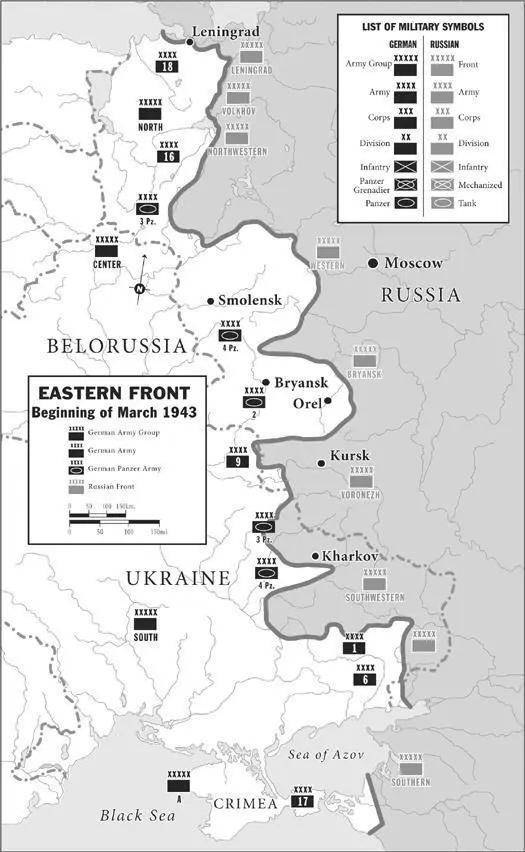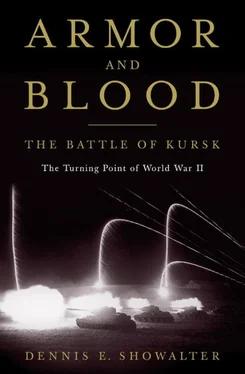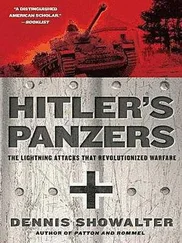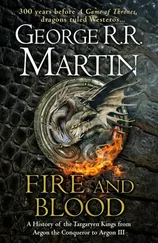Everybody on the long-designated battlefield knew what was coming. In mounting Operation Citadel, Adolf Hitler and his generals were seizing a high-risk window of opportunity: a last, best chance to regain the initiative in Russia before Soviet material power grew overwhelming and before the Western Allies could establish themselves in Europe. The Russians faced a graduation exercise: a test of their ability to handle a major and intricate combined-arms battle against a first-class, heavily armored, and experienced enemy.
For weeks, the Germans and the Russians had been massing men, tanks, guns, and aircraft from every sector of the Eastern Front into and around a hundred-mile salient centered on the Ukrainian city of Kursk, about four hundred miles south of Moscow. All that remained indefinite were the starting time and the precise locations, which Soviet intelligence had been unable to determine. Adolf Hitler had postponed the date repeatedly. At least three times the Soviet high command, known as the Stavka, had issued false warnings. Then, on the evening of July 4, 1943, the Germans sent their men the infallible signal: a special ration of schnapps. An Alsatian serving in the Waffen SS promptly deserted—and convinced a high-status interrogation team, including Voronezh Front’s commander, General Nikolai Vatutin, and a forty-nine-year-old political adviser named Nikita Khrushchev, that the German offensive would be under way before dawn on July 5. Giving the Germans the advantage of tactical surprise might be fatal. Khrushchev promptly reported to Moscow. Joseph Stalin returned the call and—according to Khrushchev—asked for his opinion. Khrushchev replied that “we will make the enemy pay in blood when he tries to break through.” At 10:30 P.M., more than six hundred heavy guns and rocket launchers began the overture to the Battle of Kursk by blasting German artillery positions and assembly areas in Voronezh Front’s sector.
The groundwork for this epic armored battle had been laid almost two years earlier, when the Wehrmacht had failed to overrun the Soviet Union in the lightning campaign projected by Operation Barbarossa. The long list of specific German mistakes can be conveniently grouped under two headings: overextension and underestimation. Both reflected the general sense of emergency that had informed Hitler’s Reich from the first days of its existence. Time was always Adolf Hitler’s chief enemy. He believed that only he could create the Thousand Year Reich of his visions, and to that end he was willing to run the most extreme risks.
Hitler’s generals shared that risk-taking mind-set and accepted the apocalyptic visions accompanying it. That congruence shaped Barbarossa’s racist, genocidal nature. Worse than a crime, it was a mistake antagonizing broad spectrums of a population that could have been mobilized to work for and with the conquerors and in some cases even act against the Soviet system. But to behave differently would have required Nazis to be something other than Nazis—and, perhaps, German generals to be something other than German generals, at least when confronting Slavic Bolsheviks.
More directly significant was an operational plan that lacked a decisive point. Instead, Barbarossa’s armored spearheads were positioned on what amounted to a starting line sent in extrinsic directions toward Leningrad, Moscow, and Kiev and increasingly worn down by being shifted from sector to sector to deal with emergencies as the Red Army fought back fiercely and effectively. Behind the front, the Soviet government mobilized resources and developed skills to frustrate the invasion, capture the initiative, and discredit the myth of an inherently superior German way of war.
The initial result was a stalemate as Soviet counteroffensives staggered the Wehrmacht but failed to shatter it. During the winter of 1941–42, both sides regrouped and reconceptualized. On April 5, 1942, Hitler issued Directive 41, outlining the operational plan for the summer of 1942. Its focus would be in the south: a major drive toward the Caucasus to destroy Soviet forces in the region and seize the oil fields vital to both Soviet and German war making. A secondary objective was Stalingrad—not for its own sake, but to cut the Volga River, isolate the Russians south of the industrial city, and cover the main assault’s flank.
The offensive’s aims were no less ambitious than Barbarossa’s had been. It would be launched on a five-hundred-mile front. Its objectives would create a salient, a bulge, of over thirteen hundred miles—something like the distance from New York City to the middle of Kansas. Road and rail networks would grow thinner as the Germans advanced. Scheduling the main attack for the end of June left at best four or five months before rain and snow put an end to major mobile operations. Even if the offensive succeeded, there was no guarantee that the Soviet Union would collapse or cease fighting de facto. It had other domestic sources of oil. It had as well the support of the United States and Great Britain, committed to keeping Russia in the war at all costs.

The operation nevertheless made sense to Hitler and his high command. It offered the opportunity to consolidate the Reich’s military and economic position against the establishment of a second front in Europe—something Hitler considered possible as early as 1943. It extended the land war into Asia Minor and beyond, where the immediate pickings and possibilities seemed somewhat easier. And it offered a second chance for the German army to do what it so far had done best: win a mobile campaign in a limited time.
Initially, Stalin and his principal military advisers expected the Germans to attack—but in the direction of Moscow, replicating their failed final drive of autumn 1941. The supreme leader, the Vozhd, proposed to respond by seizing the initiative as soon as possible with half a dozen local offensives across the entire front. His staff planners were less sanguine and less eager. Chief of Staff Boris Shaposhnikov and Aleksandr Vasilevsky, who assumed the post in May 1942 when Shaposhnikov resigned due to ill health, expected the Germans to attack again. Let them again break their teeth on Red Army defenses, then the Soviets would mount a full-scale counterstroke. Field commanders such as Semyon Timoshenko and Georgi Zhukov, who had bloodied and blunted the first German onslaught, were dubious about dissipating the strength of a still-rebuilding army, short of men and material at every level. But Zhukov was not, or not yet, the man to cross Stalin directly. And Timoshenko believed his Southwest Command Sector offered an opportunity for a major offensive to recapture the city of Kharkov, in German hands since October 1941. Stalin approved the plan.
By May 12, the men and material were in place. For the first few days, it achieved a series of local successes. Then German air and armored forces counterattacked. It took them three days to reduce the Red Army’s attack to prisoners and corpses: six hundred thousand casualties, two full armies, and two of the new tank corps destroyed, over twelve hundred tanks lost. German casualties totaled around twenty thousand—no bagatelle, but an exchange ratio suggesting strongly that Ivan was still no match for Hitler’s panzers at any level.
In fact, the Soviet offensive suffered as much from bad staff work, inadequate intelligence and reconnaissance, and chaotic logistics as it did from German tactical sophistication. For a Führer and a high command still concerned with straightening the line in the northern and central sectors, and with clearing the stubbornly defended Crimean Peninsula, Kharkov nevertheless seemed a sign from Bellona herself that even delaying the main offensive to clean up details and replace losses would have no consequences. Indeed, a later start might have advantages: the faster the pace, the less likely an effective Soviet response.
Читать дальше













